Case Study Analysis: Delict Law in Scotland - Legal Wrongs Examined
VerifiedAdded on 2021/04/17
|10
|2359
|89
Case Study
AI Summary
This document presents a comprehensive case study analysis of delict law within the Scottish legal framework. It meticulously examines a scenario involving potential legal wrongs arising from negligence, focusing on the application of key legal principles such as the duty of care, as established in Donoghue v Stevenson, and the doctrine of res ipsa loquitur. The analysis delves into the facts of the case, identifies the core legal issues, and evaluates the potential liability of involved parties, including Matthew's father. The study assesses the breach of duty of care, causation of harm, and the application of relevant legal precedents, including Muir v Glasgow Corporation and Hughes v Lord Advocate, to determine the potential for claims and the likelihood of their success. Furthermore, the analysis considers the implications of the case on various injured parties, including Ian, Angie, Simon, and Karen, and discusses the potential for claims for monetary compensation and damages, including those for mental injury and loss of earnings. The conclusion summarizes the findings, highlighting the liable party and the potential outcomes of the case under the law of delict.

qwertyuiopasdfghjklzxcvbnmqwertyui
opasdfghjklzxcvbnmqwertyuiopasdfgh
jklzxcvbnmqwertyuiopasdfghjklzxcvb
nmqwertyuiopasdfghjklzxcvbnmqwer
tyuiopasdfghjklzxcvbnmqwertyuiopas
dfghjklzxcvbnmqwertyuiopasdfghjklzx
cvbnmqwertyuiopasdfghjklzxcvbnmq
wertyuiopasdfghjklzxcvbnmqwertyuio
pasdfghjklzxcvbnmqwertyuiopasdfghj
Delict Scottish Law
Analysis of case study
24-Mar-18
(Student Details: )
opasdfghjklzxcvbnmqwertyuiopasdfgh
jklzxcvbnmqwertyuiopasdfghjklzxcvb
nmqwertyuiopasdfghjklzxcvbnmqwer
tyuiopasdfghjklzxcvbnmqwertyuiopas
dfghjklzxcvbnmqwertyuiopasdfghjklzx
cvbnmqwertyuiopasdfghjklzxcvbnmq
wertyuiopasdfghjklzxcvbnmqwertyuio
pasdfghjklzxcvbnmqwertyuiopasdfghj
Delict Scottish Law
Analysis of case study
24-Mar-18
(Student Details: )
Paraphrase This Document
Need a fresh take? Get an instant paraphrase of this document with our AI Paraphraser

Delict Scottish Law
Introduction
The area under the Scots law, dealing with the legal wrongs is delict1. Even though at
times it is deemed as being similar to negligence, the reality is that the scope of delict is quite
broad in comparison to delict. This area is largely led by common law in terms of the cases and
the courts. As a result of this, greater flexibility is provided to this area of law and changes based
on the changes in the society. The law of delict is the responsibility of making reparation based
on the contravention of obligation of care and represents the duty of refrain from indulging in
such contraventions2. In the following parts, the given case study is analysed in detail, in context
of the law of delict as is applicable under the Scots law. This would help in gaining an insight on
the possible claims which can be raised on the basis of the facts of the given case study and the
chances of success of such claims.
Issue
Based on the given facts of the case, the main issue of this case revolves around the
possibility of law of delict being applicable against Ian, Matthew or Matthew’s father for the
injuries caused to Angie, Simon, Karen and Simon’s mother.
Rule
Delict revolves around the concept of loss wrongful caused, based on the terms damnum
injuria datum. When a person P suffers wrongful loss at person D’s hands, particularly where D
1 Law of Delict
2 Jill Stirling, ‘Essential Elements of the Law of Delict’ (2018)
<https://www.goodfellowpublishers.com/free_files/Chapter%208-e27483dc4694f8071ae538c273606eb7.pdf>
accessed 24 March 2018
Page 2
Introduction
The area under the Scots law, dealing with the legal wrongs is delict1. Even though at
times it is deemed as being similar to negligence, the reality is that the scope of delict is quite
broad in comparison to delict. This area is largely led by common law in terms of the cases and
the courts. As a result of this, greater flexibility is provided to this area of law and changes based
on the changes in the society. The law of delict is the responsibility of making reparation based
on the contravention of obligation of care and represents the duty of refrain from indulging in
such contraventions2. In the following parts, the given case study is analysed in detail, in context
of the law of delict as is applicable under the Scots law. This would help in gaining an insight on
the possible claims which can be raised on the basis of the facts of the given case study and the
chances of success of such claims.
Issue
Based on the given facts of the case, the main issue of this case revolves around the
possibility of law of delict being applicable against Ian, Matthew or Matthew’s father for the
injuries caused to Angie, Simon, Karen and Simon’s mother.
Rule
Delict revolves around the concept of loss wrongful caused, based on the terms damnum
injuria datum. When a person P suffers wrongful loss at person D’s hands, particularly where D
1 Law of Delict
2 Jill Stirling, ‘Essential Elements of the Law of Delict’ (2018)
<https://www.goodfellowpublishers.com/free_files/Chapter%208-e27483dc4694f8071ae538c273606eb7.pdf>
accessed 24 March 2018
Page 2
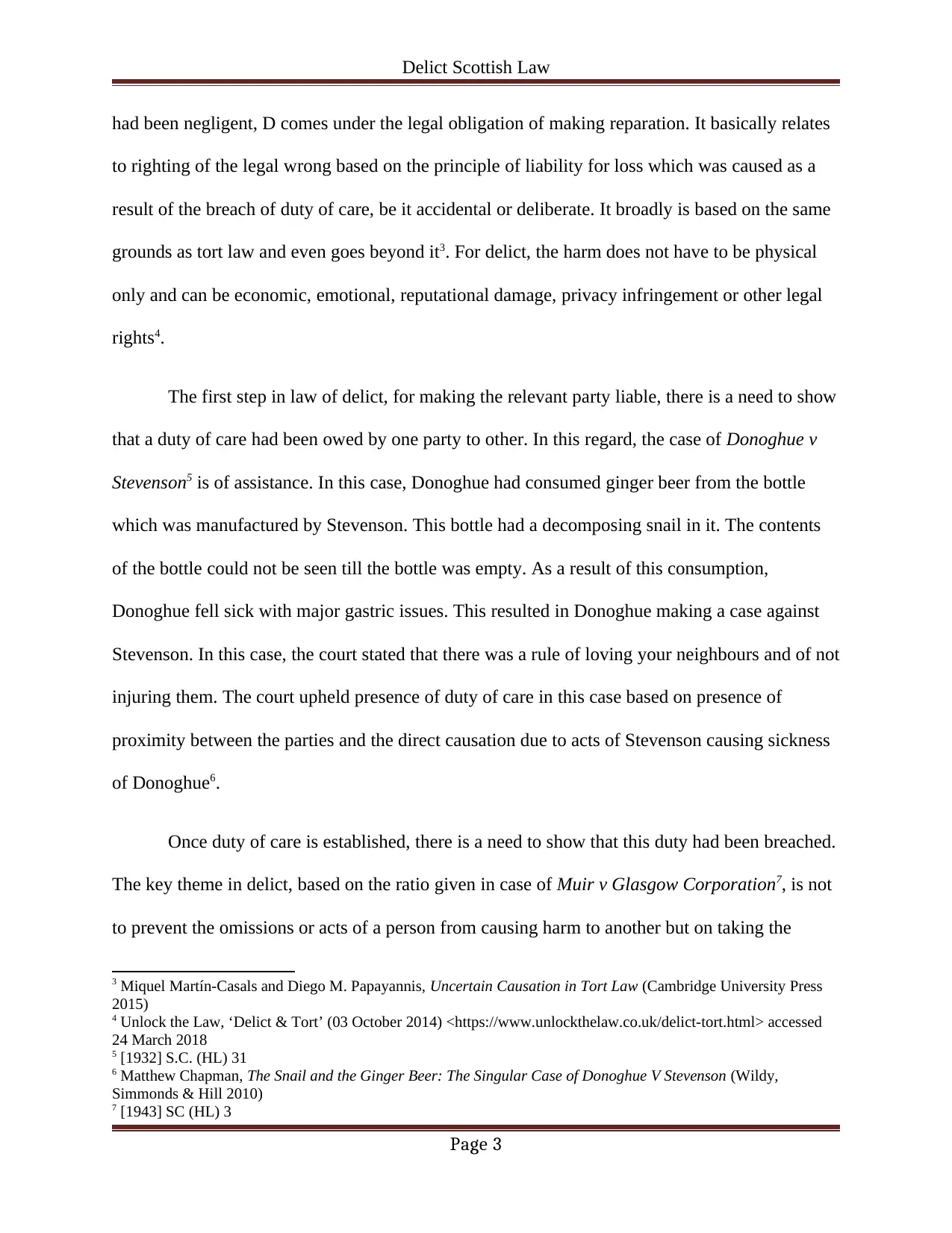
Delict Scottish Law
had been negligent, D comes under the legal obligation of making reparation. It basically relates
to righting of the legal wrong based on the principle of liability for loss which was caused as a
result of the breach of duty of care, be it accidental or deliberate. It broadly is based on the same
grounds as tort law and even goes beyond it3. For delict, the harm does not have to be physical
only and can be economic, emotional, reputational damage, privacy infringement or other legal
rights4.
The first step in law of delict, for making the relevant party liable, there is a need to show
that a duty of care had been owed by one party to other. In this regard, the case of Donoghue v
Stevenson5 is of assistance. In this case, Donoghue had consumed ginger beer from the bottle
which was manufactured by Stevenson. This bottle had a decomposing snail in it. The contents
of the bottle could not be seen till the bottle was empty. As a result of this consumption,
Donoghue fell sick with major gastric issues. This resulted in Donoghue making a case against
Stevenson. In this case, the court stated that there was a rule of loving your neighbours and of not
injuring them. The court upheld presence of duty of care in this case based on presence of
proximity between the parties and the direct causation due to acts of Stevenson causing sickness
of Donoghue6.
Once duty of care is established, there is a need to show that this duty had been breached.
The key theme in delict, based on the ratio given in case of Muir v Glasgow Corporation7, is not
to prevent the omissions or acts of a person from causing harm to another but on taking the
3 Miquel Martín-Casals and Diego M. Papayannis, Uncertain Causation in Tort Law (Cambridge University Press
2015)
4 Unlock the Law, ‘Delict & Tort’ (03 October 2014) <https://www.unlockthelaw.co.uk/delict-tort.html> accessed
24 March 2018
5 [1932] S.C. (HL) 31
6 Matthew Chapman, The Snail and the Ginger Beer: The Singular Case of Donoghue V Stevenson (Wildy,
Simmonds & Hill 2010)
7 [1943] SC (HL) 3
Page 3
had been negligent, D comes under the legal obligation of making reparation. It basically relates
to righting of the legal wrong based on the principle of liability for loss which was caused as a
result of the breach of duty of care, be it accidental or deliberate. It broadly is based on the same
grounds as tort law and even goes beyond it3. For delict, the harm does not have to be physical
only and can be economic, emotional, reputational damage, privacy infringement or other legal
rights4.
The first step in law of delict, for making the relevant party liable, there is a need to show
that a duty of care had been owed by one party to other. In this regard, the case of Donoghue v
Stevenson5 is of assistance. In this case, Donoghue had consumed ginger beer from the bottle
which was manufactured by Stevenson. This bottle had a decomposing snail in it. The contents
of the bottle could not be seen till the bottle was empty. As a result of this consumption,
Donoghue fell sick with major gastric issues. This resulted in Donoghue making a case against
Stevenson. In this case, the court stated that there was a rule of loving your neighbours and of not
injuring them. The court upheld presence of duty of care in this case based on presence of
proximity between the parties and the direct causation due to acts of Stevenson causing sickness
of Donoghue6.
Once duty of care is established, there is a need to show that this duty had been breached.
The key theme in delict, based on the ratio given in case of Muir v Glasgow Corporation7, is not
to prevent the omissions or acts of a person from causing harm to another but on taking the
3 Miquel Martín-Casals and Diego M. Papayannis, Uncertain Causation in Tort Law (Cambridge University Press
2015)
4 Unlock the Law, ‘Delict & Tort’ (03 October 2014) <https://www.unlockthelaw.co.uk/delict-tort.html> accessed
24 March 2018
5 [1932] S.C. (HL) 31
6 Matthew Chapman, The Snail and the Ginger Beer: The Singular Case of Donoghue V Stevenson (Wildy,
Simmonds & Hill 2010)
7 [1943] SC (HL) 3
Page 3
⊘ This is a preview!⊘
Do you want full access?
Subscribe today to unlock all pages.

Trusted by 1+ million students worldwide
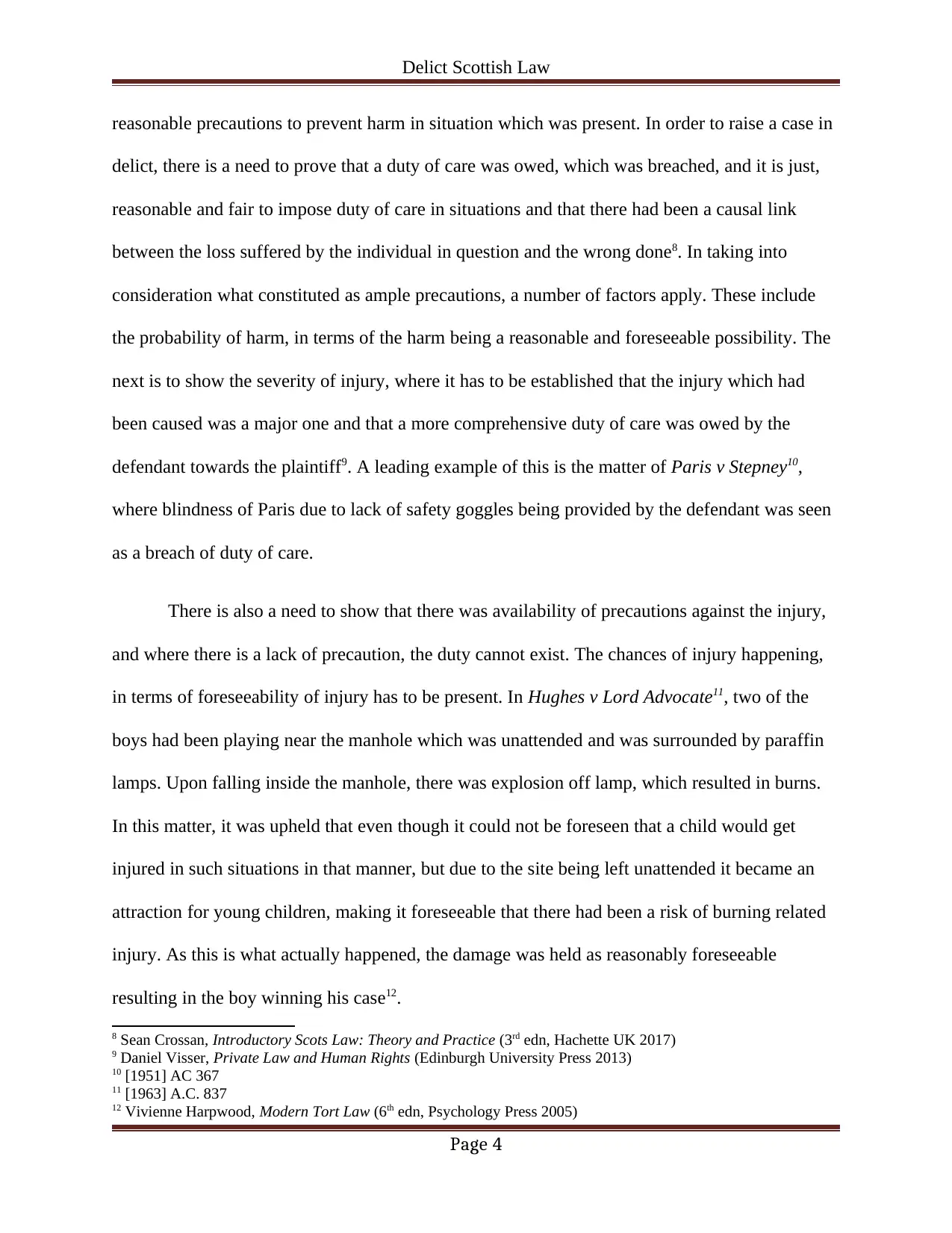
Delict Scottish Law
reasonable precautions to prevent harm in situation which was present. In order to raise a case in
delict, there is a need to prove that a duty of care was owed, which was breached, and it is just,
reasonable and fair to impose duty of care in situations and that there had been a causal link
between the loss suffered by the individual in question and the wrong done8. In taking into
consideration what constituted as ample precautions, a number of factors apply. These include
the probability of harm, in terms of the harm being a reasonable and foreseeable possibility. The
next is to show the severity of injury, where it has to be established that the injury which had
been caused was a major one and that a more comprehensive duty of care was owed by the
defendant towards the plaintiff9. A leading example of this is the matter of Paris v Stepney10,
where blindness of Paris due to lack of safety goggles being provided by the defendant was seen
as a breach of duty of care.
There is also a need to show that there was availability of precautions against the injury,
and where there is a lack of precaution, the duty cannot exist. The chances of injury happening,
in terms of foreseeability of injury has to be present. In Hughes v Lord Advocate11, two of the
boys had been playing near the manhole which was unattended and was surrounded by paraffin
lamps. Upon falling inside the manhole, there was explosion off lamp, which resulted in burns.
In this matter, it was upheld that even though it could not be foreseen that a child would get
injured in such situations in that manner, but due to the site being left unattended it became an
attraction for young children, making it foreseeable that there had been a risk of burning related
injury. As this is what actually happened, the damage was held as reasonably foreseeable
resulting in the boy winning his case12.
8 Sean Crossan, Introductory Scots Law: Theory and Practice (3rd edn, Hachette UK 2017)
9 Daniel Visser, Private Law and Human Rights (Edinburgh University Press 2013)
10 [1951] AC 367
11 [1963] A.C. 837
12 Vivienne Harpwood, Modern Tort Law (6th edn, Psychology Press 2005)
Page 4
reasonable precautions to prevent harm in situation which was present. In order to raise a case in
delict, there is a need to prove that a duty of care was owed, which was breached, and it is just,
reasonable and fair to impose duty of care in situations and that there had been a causal link
between the loss suffered by the individual in question and the wrong done8. In taking into
consideration what constituted as ample precautions, a number of factors apply. These include
the probability of harm, in terms of the harm being a reasonable and foreseeable possibility. The
next is to show the severity of injury, where it has to be established that the injury which had
been caused was a major one and that a more comprehensive duty of care was owed by the
defendant towards the plaintiff9. A leading example of this is the matter of Paris v Stepney10,
where blindness of Paris due to lack of safety goggles being provided by the defendant was seen
as a breach of duty of care.
There is also a need to show that there was availability of precautions against the injury,
and where there is a lack of precaution, the duty cannot exist. The chances of injury happening,
in terms of foreseeability of injury has to be present. In Hughes v Lord Advocate11, two of the
boys had been playing near the manhole which was unattended and was surrounded by paraffin
lamps. Upon falling inside the manhole, there was explosion off lamp, which resulted in burns.
In this matter, it was upheld that even though it could not be foreseen that a child would get
injured in such situations in that manner, but due to the site being left unattended it became an
attraction for young children, making it foreseeable that there had been a risk of burning related
injury. As this is what actually happened, the damage was held as reasonably foreseeable
resulting in the boy winning his case12.
8 Sean Crossan, Introductory Scots Law: Theory and Practice (3rd edn, Hachette UK 2017)
9 Daniel Visser, Private Law and Human Rights (Edinburgh University Press 2013)
10 [1951] AC 367
11 [1963] A.C. 837
12 Vivienne Harpwood, Modern Tort Law (6th edn, Psychology Press 2005)
Page 4
Paraphrase This Document
Need a fresh take? Get an instant paraphrase of this document with our AI Paraphraser
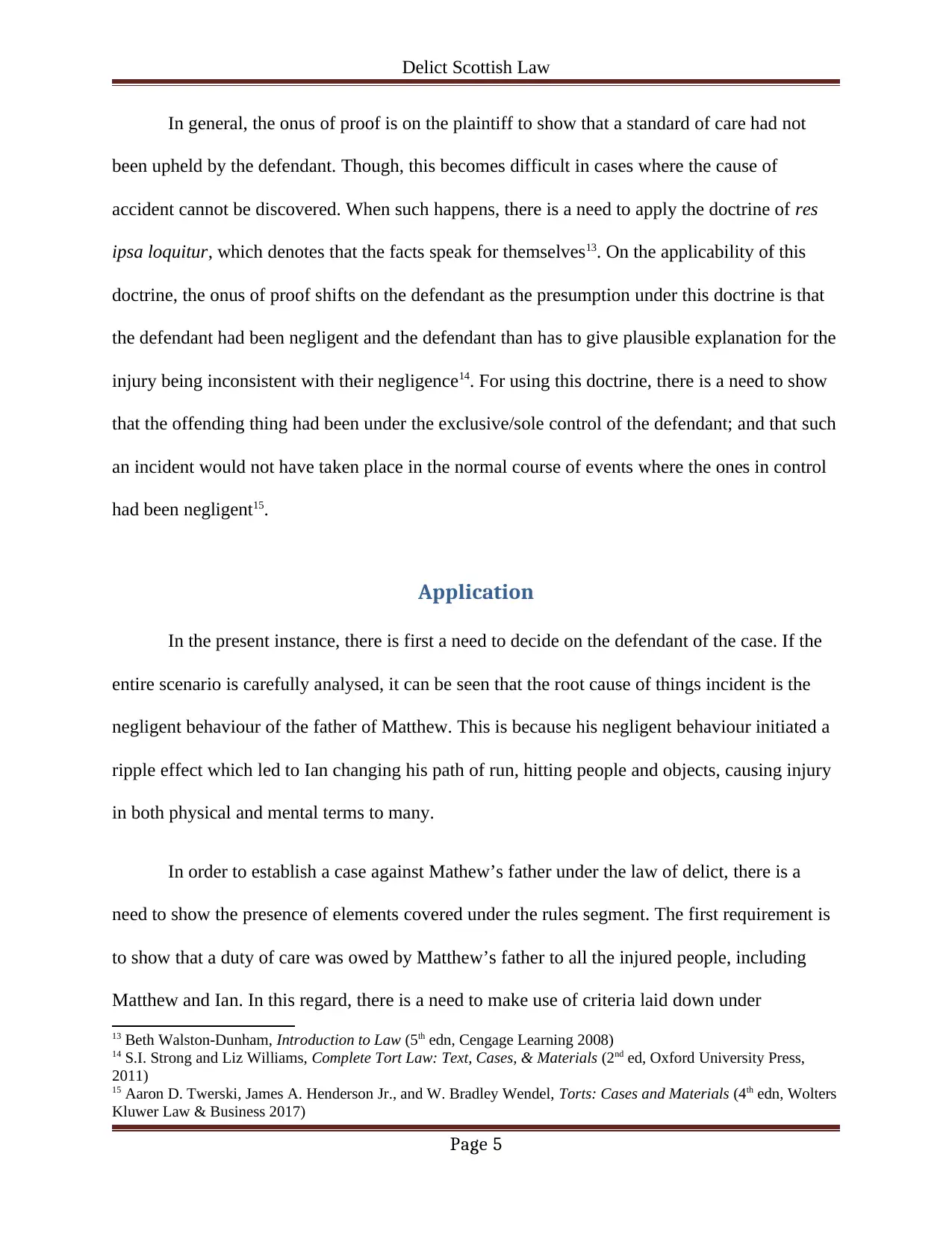
Delict Scottish Law
In general, the onus of proof is on the plaintiff to show that a standard of care had not
been upheld by the defendant. Though, this becomes difficult in cases where the cause of
accident cannot be discovered. When such happens, there is a need to apply the doctrine of res
ipsa loquitur, which denotes that the facts speak for themselves13. On the applicability of this
doctrine, the onus of proof shifts on the defendant as the presumption under this doctrine is that
the defendant had been negligent and the defendant than has to give plausible explanation for the
injury being inconsistent with their negligence14. For using this doctrine, there is a need to show
that the offending thing had been under the exclusive/sole control of the defendant; and that such
an incident would not have taken place in the normal course of events where the ones in control
had been negligent15.
Application
In the present instance, there is first a need to decide on the defendant of the case. If the
entire scenario is carefully analysed, it can be seen that the root cause of things incident is the
negligent behaviour of the father of Matthew. This is because his negligent behaviour initiated a
ripple effect which led to Ian changing his path of run, hitting people and objects, causing injury
in both physical and mental terms to many.
In order to establish a case against Mathew’s father under the law of delict, there is a
need to show the presence of elements covered under the rules segment. The first requirement is
to show that a duty of care was owed by Matthew’s father to all the injured people, including
Matthew and Ian. In this regard, there is a need to make use of criteria laid down under
13 Beth Walston-Dunham, Introduction to Law (5th edn, Cengage Learning 2008)
14 S.I. Strong and Liz Williams, Complete Tort Law: Text, Cases, & Materials (2nd ed, Oxford University Press,
2011)
15 Aaron D. Twerski, James A. Henderson Jr., and W. Bradley Wendel, Torts: Cases and Materials (4th edn, Wolters
Kluwer Law & Business 2017)
Page 5
In general, the onus of proof is on the plaintiff to show that a standard of care had not
been upheld by the defendant. Though, this becomes difficult in cases where the cause of
accident cannot be discovered. When such happens, there is a need to apply the doctrine of res
ipsa loquitur, which denotes that the facts speak for themselves13. On the applicability of this
doctrine, the onus of proof shifts on the defendant as the presumption under this doctrine is that
the defendant had been negligent and the defendant than has to give plausible explanation for the
injury being inconsistent with their negligence14. For using this doctrine, there is a need to show
that the offending thing had been under the exclusive/sole control of the defendant; and that such
an incident would not have taken place in the normal course of events where the ones in control
had been negligent15.
Application
In the present instance, there is first a need to decide on the defendant of the case. If the
entire scenario is carefully analysed, it can be seen that the root cause of things incident is the
negligent behaviour of the father of Matthew. This is because his negligent behaviour initiated a
ripple effect which led to Ian changing his path of run, hitting people and objects, causing injury
in both physical and mental terms to many.
In order to establish a case against Mathew’s father under the law of delict, there is a
need to show the presence of elements covered under the rules segment. The first requirement is
to show that a duty of care was owed by Matthew’s father to all the injured people, including
Matthew and Ian. In this regard, there is a need to make use of criteria laid down under
13 Beth Walston-Dunham, Introduction to Law (5th edn, Cengage Learning 2008)
14 S.I. Strong and Liz Williams, Complete Tort Law: Text, Cases, & Materials (2nd ed, Oxford University Press,
2011)
15 Aaron D. Twerski, James A. Henderson Jr., and W. Bradley Wendel, Torts: Cases and Materials (4th edn, Wolters
Kluwer Law & Business 2017)
Page 5
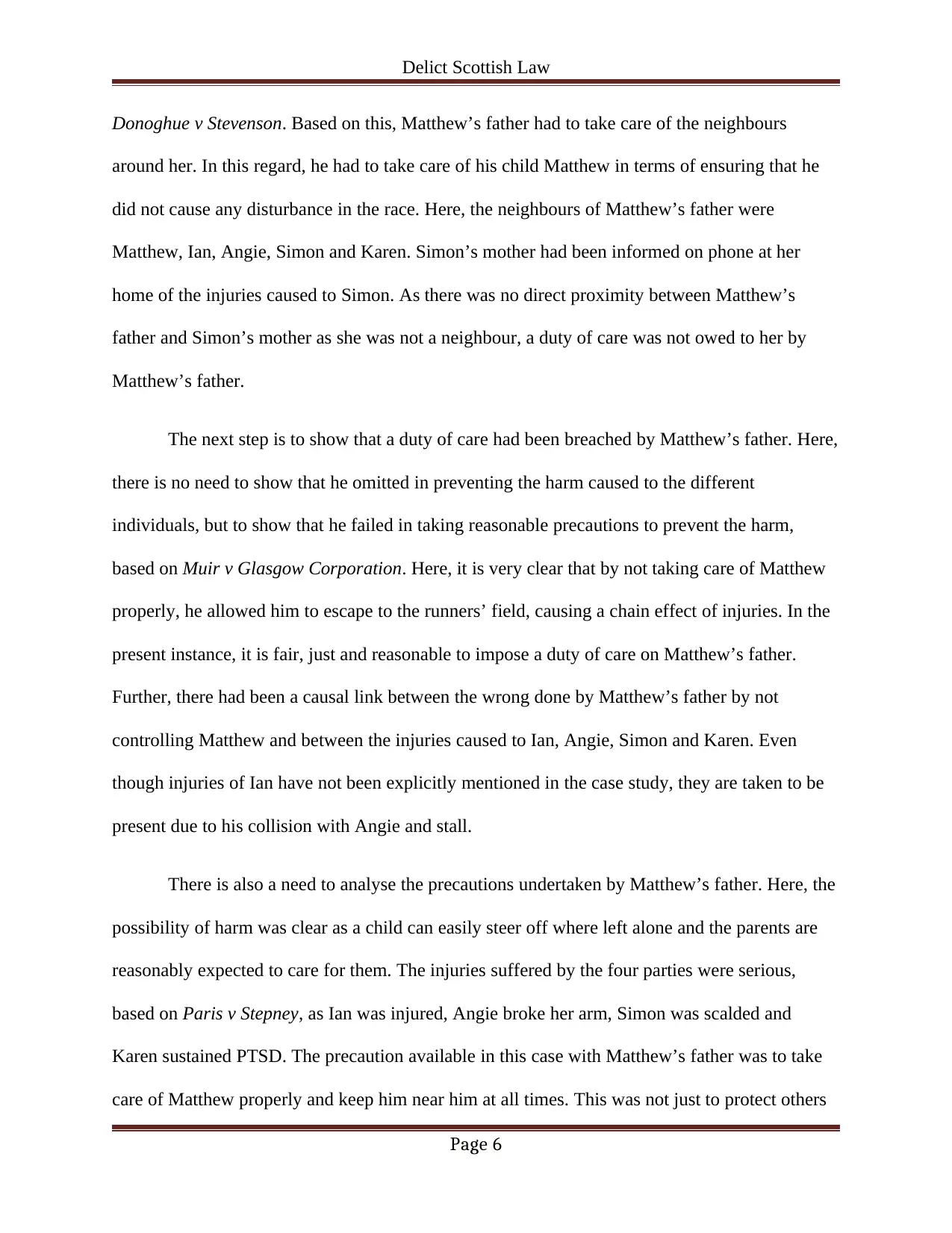
Delict Scottish Law
Donoghue v Stevenson. Based on this, Matthew’s father had to take care of the neighbours
around her. In this regard, he had to take care of his child Matthew in terms of ensuring that he
did not cause any disturbance in the race. Here, the neighbours of Matthew’s father were
Matthew, Ian, Angie, Simon and Karen. Simon’s mother had been informed on phone at her
home of the injuries caused to Simon. As there was no direct proximity between Matthew’s
father and Simon’s mother as she was not a neighbour, a duty of care was not owed to her by
Matthew’s father.
The next step is to show that a duty of care had been breached by Matthew’s father. Here,
there is no need to show that he omitted in preventing the harm caused to the different
individuals, but to show that he failed in taking reasonable precautions to prevent the harm,
based on Muir v Glasgow Corporation. Here, it is very clear that by not taking care of Matthew
properly, he allowed him to escape to the runners’ field, causing a chain effect of injuries. In the
present instance, it is fair, just and reasonable to impose a duty of care on Matthew’s father.
Further, there had been a causal link between the wrong done by Matthew’s father by not
controlling Matthew and between the injuries caused to Ian, Angie, Simon and Karen. Even
though injuries of Ian have not been explicitly mentioned in the case study, they are taken to be
present due to his collision with Angie and stall.
There is also a need to analyse the precautions undertaken by Matthew’s father. Here, the
possibility of harm was clear as a child can easily steer off where left alone and the parents are
reasonably expected to care for them. The injuries suffered by the four parties were serious,
based on Paris v Stepney, as Ian was injured, Angie broke her arm, Simon was scalded and
Karen sustained PTSD. The precaution available in this case with Matthew’s father was to take
care of Matthew properly and keep him near him at all times. This was not just to protect others
Page 6
Donoghue v Stevenson. Based on this, Matthew’s father had to take care of the neighbours
around her. In this regard, he had to take care of his child Matthew in terms of ensuring that he
did not cause any disturbance in the race. Here, the neighbours of Matthew’s father were
Matthew, Ian, Angie, Simon and Karen. Simon’s mother had been informed on phone at her
home of the injuries caused to Simon. As there was no direct proximity between Matthew’s
father and Simon’s mother as she was not a neighbour, a duty of care was not owed to her by
Matthew’s father.
The next step is to show that a duty of care had been breached by Matthew’s father. Here,
there is no need to show that he omitted in preventing the harm caused to the different
individuals, but to show that he failed in taking reasonable precautions to prevent the harm,
based on Muir v Glasgow Corporation. Here, it is very clear that by not taking care of Matthew
properly, he allowed him to escape to the runners’ field, causing a chain effect of injuries. In the
present instance, it is fair, just and reasonable to impose a duty of care on Matthew’s father.
Further, there had been a causal link between the wrong done by Matthew’s father by not
controlling Matthew and between the injuries caused to Ian, Angie, Simon and Karen. Even
though injuries of Ian have not been explicitly mentioned in the case study, they are taken to be
present due to his collision with Angie and stall.
There is also a need to analyse the precautions undertaken by Matthew’s father. Here, the
possibility of harm was clear as a child can easily steer off where left alone and the parents are
reasonably expected to care for them. The injuries suffered by the four parties were serious,
based on Paris v Stepney, as Ian was injured, Angie broke her arm, Simon was scalded and
Karen sustained PTSD. The precaution available in this case with Matthew’s father was to take
care of Matthew properly and keep him near him at all times. This was not just to protect others
Page 6
⊘ This is a preview!⊘
Do you want full access?
Subscribe today to unlock all pages.

Trusted by 1+ million students worldwide
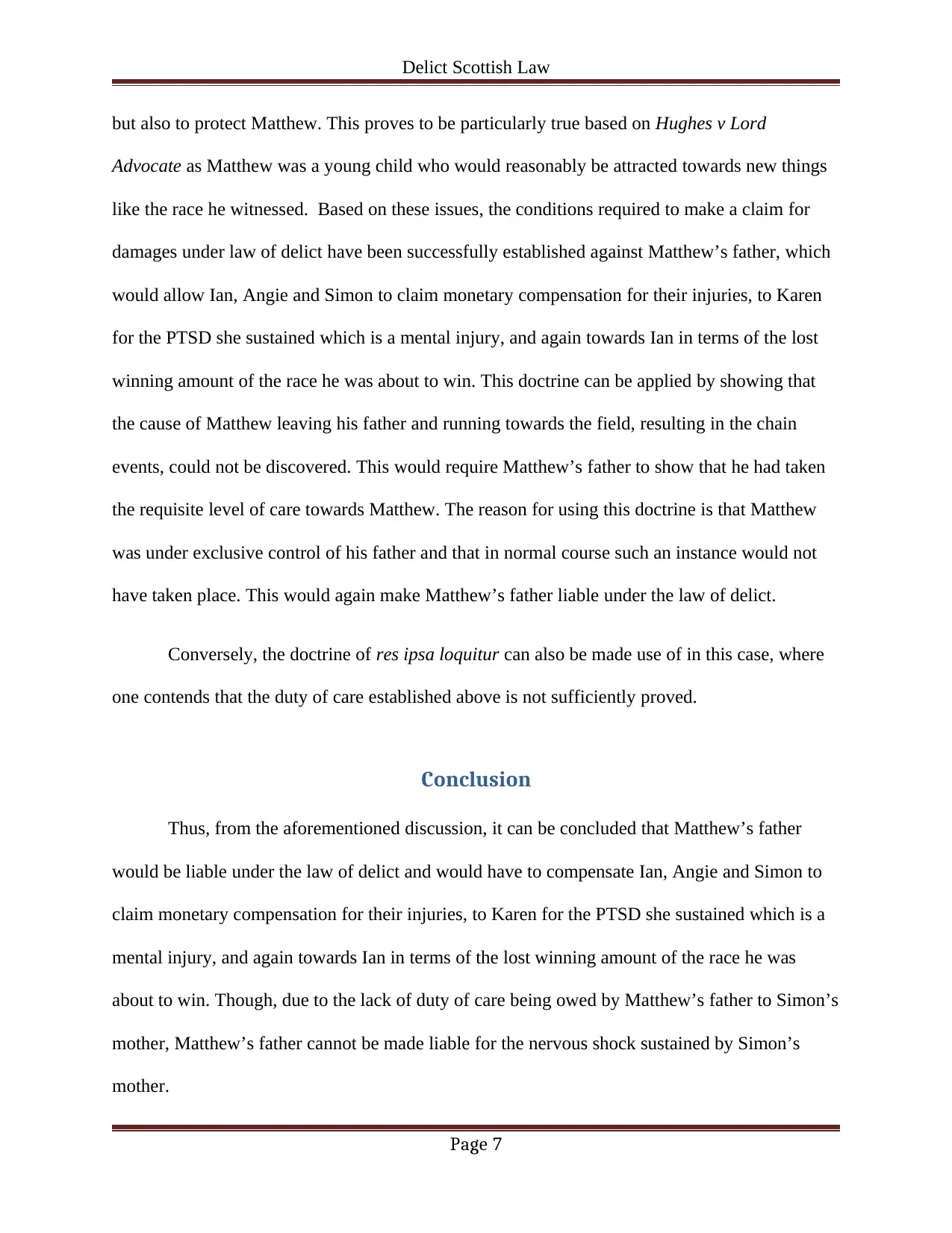
Delict Scottish Law
but also to protect Matthew. This proves to be particularly true based on Hughes v Lord
Advocate as Matthew was a young child who would reasonably be attracted towards new things
like the race he witnessed. Based on these issues, the conditions required to make a claim for
damages under law of delict have been successfully established against Matthew’s father, which
would allow Ian, Angie and Simon to claim monetary compensation for their injuries, to Karen
for the PTSD she sustained which is a mental injury, and again towards Ian in terms of the lost
winning amount of the race he was about to win. This doctrine can be applied by showing that
the cause of Matthew leaving his father and running towards the field, resulting in the chain
events, could not be discovered. This would require Matthew’s father to show that he had taken
the requisite level of care towards Matthew. The reason for using this doctrine is that Matthew
was under exclusive control of his father and that in normal course such an instance would not
have taken place. This would again make Matthew’s father liable under the law of delict.
Conversely, the doctrine of res ipsa loquitur can also be made use of in this case, where
one contends that the duty of care established above is not sufficiently proved.
Conclusion
Thus, from the aforementioned discussion, it can be concluded that Matthew’s father
would be liable under the law of delict and would have to compensate Ian, Angie and Simon to
claim monetary compensation for their injuries, to Karen for the PTSD she sustained which is a
mental injury, and again towards Ian in terms of the lost winning amount of the race he was
about to win. Though, due to the lack of duty of care being owed by Matthew’s father to Simon’s
mother, Matthew’s father cannot be made liable for the nervous shock sustained by Simon’s
mother.
Page 7
but also to protect Matthew. This proves to be particularly true based on Hughes v Lord
Advocate as Matthew was a young child who would reasonably be attracted towards new things
like the race he witnessed. Based on these issues, the conditions required to make a claim for
damages under law of delict have been successfully established against Matthew’s father, which
would allow Ian, Angie and Simon to claim monetary compensation for their injuries, to Karen
for the PTSD she sustained which is a mental injury, and again towards Ian in terms of the lost
winning amount of the race he was about to win. This doctrine can be applied by showing that
the cause of Matthew leaving his father and running towards the field, resulting in the chain
events, could not be discovered. This would require Matthew’s father to show that he had taken
the requisite level of care towards Matthew. The reason for using this doctrine is that Matthew
was under exclusive control of his father and that in normal course such an instance would not
have taken place. This would again make Matthew’s father liable under the law of delict.
Conversely, the doctrine of res ipsa loquitur can also be made use of in this case, where
one contends that the duty of care established above is not sufficiently proved.
Conclusion
Thus, from the aforementioned discussion, it can be concluded that Matthew’s father
would be liable under the law of delict and would have to compensate Ian, Angie and Simon to
claim monetary compensation for their injuries, to Karen for the PTSD she sustained which is a
mental injury, and again towards Ian in terms of the lost winning amount of the race he was
about to win. Though, due to the lack of duty of care being owed by Matthew’s father to Simon’s
mother, Matthew’s father cannot be made liable for the nervous shock sustained by Simon’s
mother.
Page 7
Paraphrase This Document
Need a fresh take? Get an instant paraphrase of this document with our AI Paraphraser
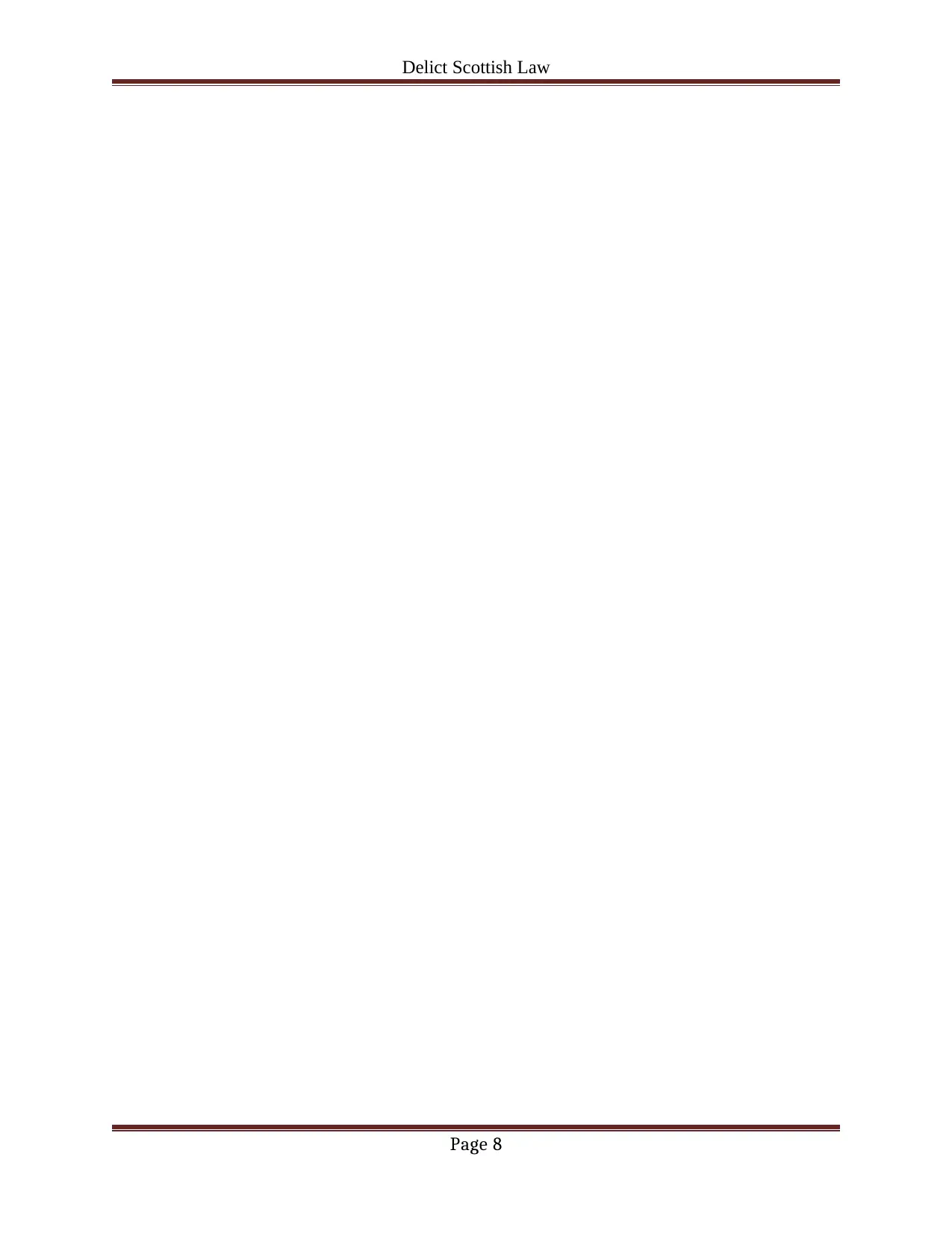
Delict Scottish Law
Page 8
Page 8
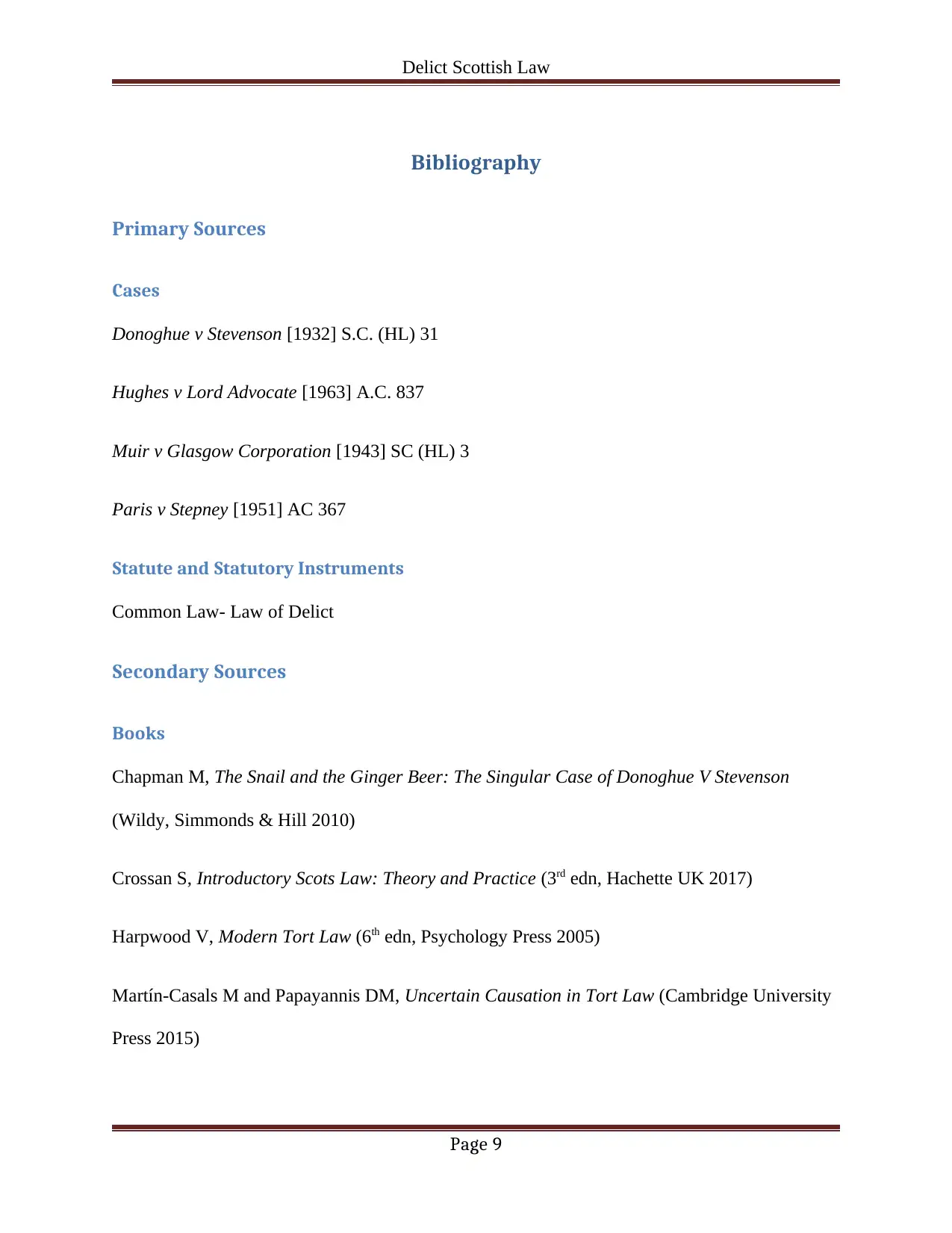
Delict Scottish Law
Bibliography
Primary Sources
Cases
Donoghue v Stevenson [1932] S.C. (HL) 31
Hughes v Lord Advocate [1963] A.C. 837
Muir v Glasgow Corporation [1943] SC (HL) 3
Paris v Stepney [1951] AC 367
Statute and Statutory Instruments
Common Law- Law of Delict
Secondary Sources
Books
Chapman M, The Snail and the Ginger Beer: The Singular Case of Donoghue V Stevenson
(Wildy, Simmonds & Hill 2010)
Crossan S, Introductory Scots Law: Theory and Practice (3rd edn, Hachette UK 2017)
Harpwood V, Modern Tort Law (6th edn, Psychology Press 2005)
Martín-Casals M and Papayannis DM, Uncertain Causation in Tort Law (Cambridge University
Press 2015)
Page 9
Bibliography
Primary Sources
Cases
Donoghue v Stevenson [1932] S.C. (HL) 31
Hughes v Lord Advocate [1963] A.C. 837
Muir v Glasgow Corporation [1943] SC (HL) 3
Paris v Stepney [1951] AC 367
Statute and Statutory Instruments
Common Law- Law of Delict
Secondary Sources
Books
Chapman M, The Snail and the Ginger Beer: The Singular Case of Donoghue V Stevenson
(Wildy, Simmonds & Hill 2010)
Crossan S, Introductory Scots Law: Theory and Practice (3rd edn, Hachette UK 2017)
Harpwood V, Modern Tort Law (6th edn, Psychology Press 2005)
Martín-Casals M and Papayannis DM, Uncertain Causation in Tort Law (Cambridge University
Press 2015)
Page 9
⊘ This is a preview!⊘
Do you want full access?
Subscribe today to unlock all pages.

Trusted by 1+ million students worldwide
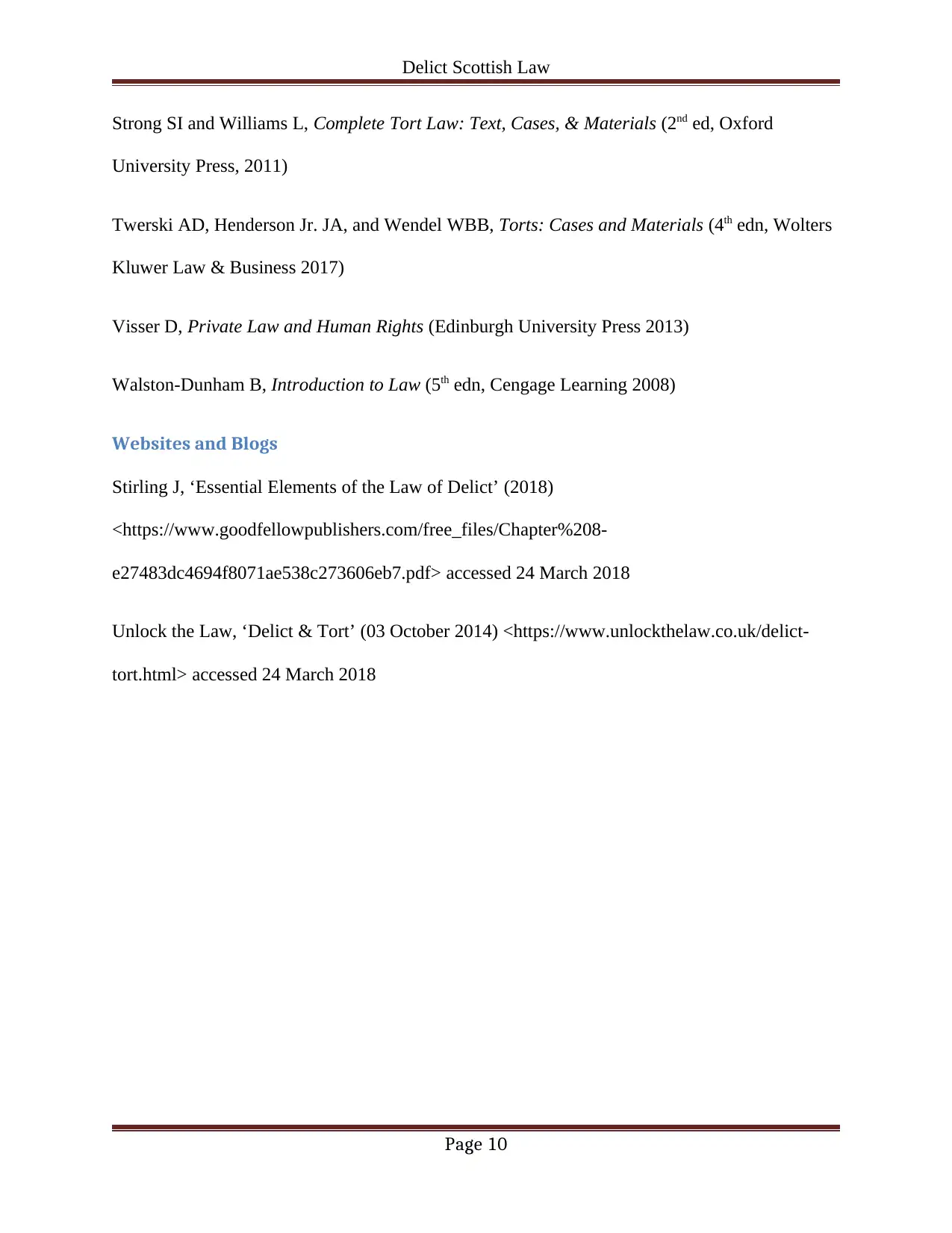
Delict Scottish Law
Strong SI and Williams L, Complete Tort Law: Text, Cases, & Materials (2nd ed, Oxford
University Press, 2011)
Twerski AD, Henderson Jr. JA, and Wendel WBB, Torts: Cases and Materials (4th edn, Wolters
Kluwer Law & Business 2017)
Visser D, Private Law and Human Rights (Edinburgh University Press 2013)
Walston-Dunham B, Introduction to Law (5th edn, Cengage Learning 2008)
Websites and Blogs
Stirling J, ‘Essential Elements of the Law of Delict’ (2018)
<https://www.goodfellowpublishers.com/free_files/Chapter%208-
e27483dc4694f8071ae538c273606eb7.pdf> accessed 24 March 2018
Unlock the Law, ‘Delict & Tort’ (03 October 2014) <https://www.unlockthelaw.co.uk/delict-
tort.html> accessed 24 March 2018
Page 10
Strong SI and Williams L, Complete Tort Law: Text, Cases, & Materials (2nd ed, Oxford
University Press, 2011)
Twerski AD, Henderson Jr. JA, and Wendel WBB, Torts: Cases and Materials (4th edn, Wolters
Kluwer Law & Business 2017)
Visser D, Private Law and Human Rights (Edinburgh University Press 2013)
Walston-Dunham B, Introduction to Law (5th edn, Cengage Learning 2008)
Websites and Blogs
Stirling J, ‘Essential Elements of the Law of Delict’ (2018)
<https://www.goodfellowpublishers.com/free_files/Chapter%208-
e27483dc4694f8071ae538c273606eb7.pdf> accessed 24 March 2018
Unlock the Law, ‘Delict & Tort’ (03 October 2014) <https://www.unlockthelaw.co.uk/delict-
tort.html> accessed 24 March 2018
Page 10
1 out of 10
Related Documents
Your All-in-One AI-Powered Toolkit for Academic Success.
+13062052269
info@desklib.com
Available 24*7 on WhatsApp / Email
![[object Object]](/_next/static/media/star-bottom.7253800d.svg)
Unlock your academic potential
Copyright © 2020–2025 A2Z Services. All Rights Reserved. Developed and managed by ZUCOL.





